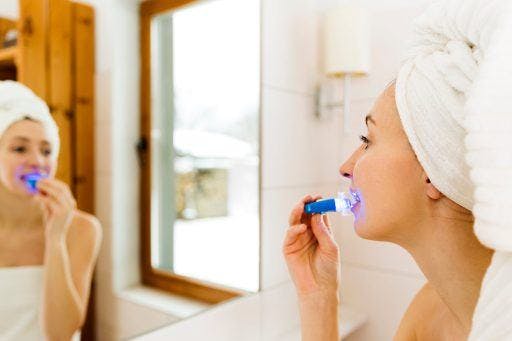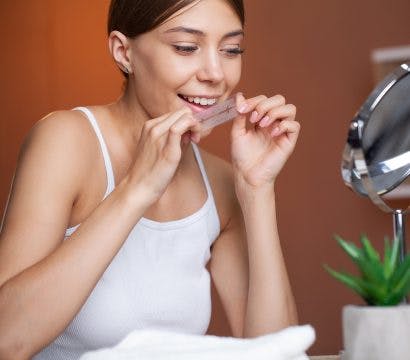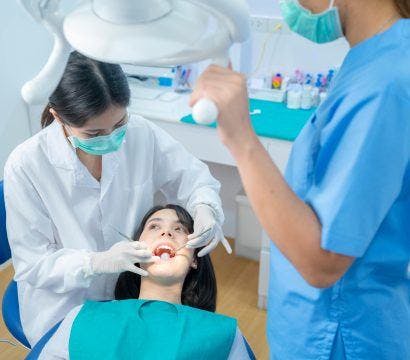White teeth are always in, especially now that you can just CGI or filter your way to glistening pearly whites. But nothing beats the real deal. And thanks to the many teeth-whitening options available, brightening your smile has never been easier.
Still, it pays to know what you’re getting into before you start chasing a beauty queen or celebrity smile. Keep reading to learn more about teeth whitening, its history and modern developments, and your options.
What is teeth whitening?
Teeth whitening is the process of lightening your teeth’s colour.
For professional treatment, you can see a dentist, dental hygienist, or oral health therapist. They’ll go over your options with you, and you can choose between ‘in-chair’ and ‘take-home’ teeth whitening solutions.
In-chair teeth whitening must take place in a dental clinic. This treatment involves applying a strong hydrogen peroxide gel to your teeth, often followed by UV light exposure. You’ll get immediate results, but may have to apply additional products to make the effects last longer.
You can buy do-it-yourself (DIY) options online and in pharmacies. But the Australian Dental Association (ADA) recommends having a dentist supervise take-home teeth whitening solutions. These involve putting gel into plastic trays moulded to fit your mouth and wearing these for some time each day over a set period.
Your dentist will instruct you on how much gel to apply, how long to wear the trays, and how many days or weeks the process takes to complete. The effects may take longer to become obvious, but you’ll enjoy the convenience. Teeth whitening is also generally less intensive with a dentist.
The risk of teeth whitening
While teeth-whitening options from the shops may seem cheap and convenient, keep in mind the DIY method could lead to teeth pain or sensitivity. Do you want to risk tooth pain or sensitivity or not having the process work how you want it to?
Seeing a dentist, dental hygienist, or oral health practitioner reduces the risk of things going wrong. They can assess the causes, suggest whitening solutions tailored to specific needs or medical conditions, and monitor for any reactions to the chemicals used. If you have braces, retainers, or clear aligners, your dentist or orthodontist can suggest the best option for you.
Tooth discolouration can have different causes, which leads to varying solutions or a combination of treatments to address the underlying cause.
For example, dental plaque calcification could cause tartar to form on your teeth, turning them yellow. Your dentist will likely remove this before starting any whitening treatments. Untreated tooth decay can also lead to severe tooth sensitivity and even pain during the whitening process. If you have crowns or other dental impacts, they can also affect the success of the treatment.
Teeth whitening can also cause complications for pregnant or breastfeeding women, so it’s crucial to check with a dentist or doctor before starting any treatments.
Teeth-whitening origins

Did you know the hyper-fixation on perfectly white smiles isn’t a 21st-century trend? Porcelain-like teeth have been the beauty standard since before toothpaste was on the market. Why are humans obsessed with teeth whitening? Let’s dig deep into history to find the answer.
Polishing and brightening teeth is a habit older than toilet paper and electricity. Around 4,000 years ago, the ancient Egyptians whitened their teeth with a homemade paste. They would grind pumice stones and mix the powder with white vinegar. This process popularised the white teeth look, which became a status of wealth and beauty in those days.
While Cleopatra might have used a pumice stone to maintain her pearly whites, Julius Caesar had a different approach. The ancient Romans were unafraid to repurpose pee as a teeth-whitening mouthwash. Although repulsive, this trick worked well. Urine contains ammonia, a compound now employed as a cleaning agent in modern times.
Sometime later, people began cleaning their teeth with chew sticks made of a miswak twig. Rubbing soot and chalk on teeth to bring out the natural brightness of enamel later became standard.
By the 17th century, barbers added “teeth whitening” to their catalogue. This service included filing down the teeth and applying nitric acid. Did it work? Yes, but it led to bronchitis and tooth decay. By the 1840s, the first teeth whitener with chloride was introduced.
The science of modern teeth whitening
The 19th century marked the beginning of professional teeth bleaching. With the popularity of chloride for teeth whitening, more effective techniques came about using sodium hypochlorite and oxalic acid. Dentists saw a breakthrough when they discovered hydrogen peroxide, a solution for treating gum disease that could lighten teeth by several shades.
In the 1960s, Dr Bill Klusmier invented the first successful home teeth-whitening kit – Gly-Oxide. The product included a custom-made mouth tray that contained 10% carbamide peroxide. More companies followed suit and tested different concentrations of hydrogen and carbamide peroxide.
Currently, 15% to 40% peroxide is the golden standard of bleaching gel for laser teeth whitening and at-home kits. When applied to the teeth, carbamide peroxide releases hydrogen peroxide, breaking down the chemical structure of tooth stains. The higher the peroxide concentration, the faster it brightens teeth.
The benefits of whiter teeth

From rinsing with urine to applying bleaching gel, humans have gone to great lengths to achieve white-as-snow teeth.
Although the average in-clinic teeth whitening cost can reach hundreds of dollars, it may be a worthy investment. It can give you sparkling white teeth but also a social confidence boost. According to various studies, a “perfect” smile reinforces your likability and socioeconomic status in several ways.
More success in dating
What makes a person attractive? It’s not just the hair or the face. Turns out, teeth are one of the biggest indicators when it comes to pre-screening potential partners.
A PLOS One study reports both men and women prefer partners with white, straight teeth. This finding is also supported by a Match.com survey in which 37% of singles claim to judge a date by their teeth or smile. So if you want to take someone’s breath away, smile and show those pearly whites!
A career boost
Teeth can be just as important as a resume while job hunting. A study titled “The Impact of Whiter Teeth on Key First Impressions” shows that people with whitened teeth are more likely to get jobs and receive higher salaries.
A bright smile supposedly makes you look more professional, confident, trustworthy, and outgoing. Plus, it shows your diligence and attentiveness in caring for oral health. For many people, white teeth also symbolise financial success.
However, it’s important to avoid striving for unrealistic beauty standards. Even if you don’t go for the teeth-whitening method, by taking care of your oral health, you’ll be able to flash a smile to be proud of.
Better first impressions
Whether you want to charm your future in-laws, associates, or a family relative, the best icebreaker is a blinding white smile. In a survey from the American Academy of Cosmetic Dentistry, 48% of the participants say they most remember a person’s smile after their first meeting. Nearly half of the participants also believe that a smile is the most attractive feature anyone can have, regardless of age.
Apart from the whiteness, how straight your teeth are plays a role, too. The same survey mentioned indicates that straighter teeth can elevate attractiveness. Fixing crooked teeth can also improve your oral health, as food will no longer become stuck in hard-to-reach places. Consult your dentist for recommendations on achieving your ideal smile.
You may want to ask if you’d be a good candidate for ClearCorrect.
These aligners feature a patented ClearQuartz tri-layer material, which keeps it stain-resistant. The aligners also have a high and flat trimline scientifically proven to optimise force transmission, resulting in more accurate tooth movement and enhanced root control.
Take this online smile assessment to find out if you’re a candidate for ClearCorrect aligners.
Can you whiten teeth while wearing clear aligners?

The short answer is – yes, you can whiten your teeth while wearing clear aligners.
The Australian Society of Orthodontists explains that any sensitivity or soreness during treatment stems from the slight pressure of the aligners and not from enamel erosion. The latter is a crucial concern since whitening, when performed incorrectly, can damage your teeth.
So, as long as you have no pre-existing dental issues, you can use teeth-whitening products and aligners together. However, you should still consult your dentist for the safest solution given your dental history and lifestyle.
How to whiten teeth with aligners
The average teeth alignment process is 12 months. Is waiting a year (or more) to whiten your teeth too long? You can try these treatment options, which are generally safe and effective for clear-aligner users.
1. Whitening gel
You can get whitening gels from supermarkets or your neighbourhood dental clinics. Most gels contain hydrogen or carbamide peroxide, the same chemicals dentists use for laser teeth-whitening. The difference is the concentration. At-home kits have a lower concentration of peroxide, which makes them failproof for beginners but still effective.
Whitening gel packages feature the gel, plus syringes and orthodontic trays. Swap the trays with your aligners. The study “Tooth Whitening in Association with Clear Aligner Treatment” finds that using clear aligners as whitening trays improves tooth shade.
Use the syringe to apply a tiny amount of gel inside the aligners. Put them on your teeth and swab the excess gel that oozes out of the trays with a cotton bud. After 45 minutes, remove your aligners and clean them thoroughly. Brush your teeth as well and pop the aligners back in. You’ll see results in about one to two weeks.
2. Whitening toothpaste
If you naturally have white teeth, whitening toothpaste can polish your enamel with minimum side effects. Some ingredients are better than others. For example, hydrogen peroxide-based toothpaste works best at removing stains, but it can damage the surfaces of your teeth if used long-term.
On the flip side, the Dentistry Journal claims toothpaste containing hydrated silica is less abrasive and can whiten teeth effectively.
Your pick in toothpaste won’t go far if you don’t practise proper teeth-cleaning. Brush your teeth at least twice daily, after waking up and before sleeping. Remember to floss, rinse your mouth, and clean your tongue for fresh breath and a beaming smile.
3. Whitening pen
For more instant results, try a whitening pen. It’s a portable version of whitening gel since it contains the same peroxide chemicals. When you “paint” over your teeth with the pen, it leaves a film of bleaching agent that becomes solid after a few minutes. This new layer makes your teeth look visibly brighter right after use.
The benefit of using this magic pen is you can whiten your teeth at any time – before a presentation, a romantic date, or a photo shoot. However, consider two downsides. First, the whitening effect is not long-lasting, as the film will dissolve when you brush your teeth. Most importantly, don’t overuse a whitening pen because the ingredients can irritate your gums and thin out your enamel.
Access to safe teeth-whitening procedures and brace-free orthodontics are the perks of living in the 21st century. Your dream smile is within your reach with an easy smile makeover! One pearl of wisdom – your self-worth is not solely dictated by how shiny your teeth look. Do what makes you feel your best.
References:
Best Face Forward. (n.d.).
Carey, C. M. (2014). Tooth Whitening: What We Now Know. Journal of Evidence Based Dental Practice, 14, 70–76.
Hendrie, C., & Brewer, G. (2012). Evidence to Suggest That Teeth Act as Human Ornament Displays Signalling Mate Quality. PLOS ONE, 7(7), e42178.
Khashashneh, M., Ratnayake, J., Choi, J. J. E., Mei, L., Lyons, K., & Brunton, P. A. (2022b). The Effectiveness of Dental Bleaching during Orthodontic Treatment with Clear Aligners: A Systematic Review. Applied Sciences, 12(21), 11274.
New Study Shows Whiter Teeth Can Lead to Greater Success in Work and Love. (n.d.).
Newton, J. T., Subramanian, S., Westland, S., Gupta, A., Luo, W., & Joiner, A. (2021). The impact of tooth colour on the perceptions of age and social judgements. Journal of Dentistry, 112, 103771.
Patel, H. (2022). Essential principles of tooth whitening. BDJ in Practice, 35(9), 46.
Suriyasangpetch, S., Sivavong, P., Niyatiwatchanchai, B., Osathanon, T., Gorwong, P., Pianmee, C., & Nantanapiboon, D. (2022). Effect of Whitening Toothpaste on Surface Roughness and Colour Alteration of Artificially Extrinsic Stained Human Enamel: In Vitro Study. Dentistry Journal, 10(10), 191.
Torres, V. M., Lima, M. J. P., Valdrighi, H. C., De Jesus Campos, E., & Santamaria, M. P. (2020). Whitening Dentifrices Effect on Enamel with Orthodontic Braces after Simulated Brushing. European Journal of Dentistry, 14(01), 013–018.
Teeth whitening. Teeth.org.au
4 reasons to see a dentist for Teeth Whitening. Teeth.org.au



